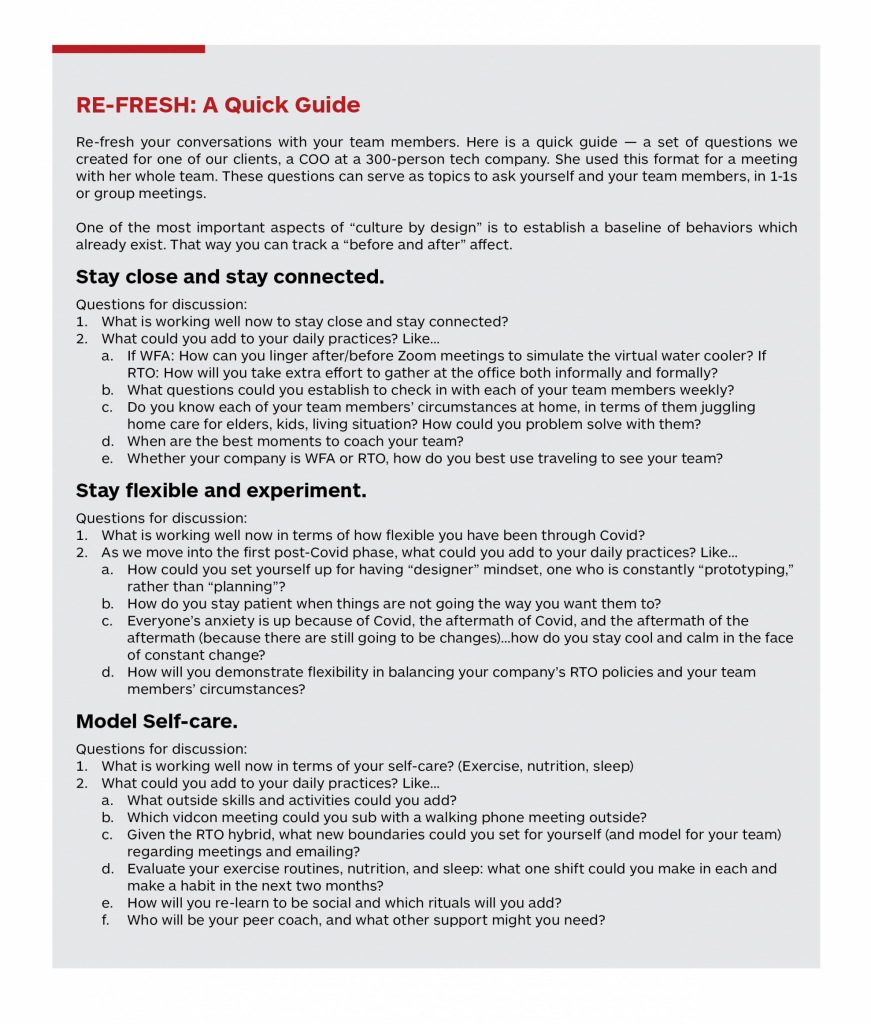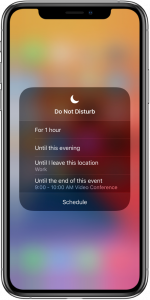A personal perspective on leading differently in the next pandemic transition
We have choices as we emerge from the pandemic: We can go back to what now seems like an unsustainable pre-Covid frenetic pace, or we can use this next pandemic transition phase to start afresh, to have different kinds of conversations with our teams (and ourselves). What’s at stake is our well-being, actually. The pandemic has taken its toll on us (collectively and individually), and we are still in the midst of having to weather a storm unlike any other in our lifetimes.
So, let us admit that we are more fragile now; that we need to be more patient with each other; and that we need to be more mindful about truly understanding each other and not leave it to happenstance or the occasional meetup.
This next pandemic transition is an opportunity for leaders to be real: We can focus on bringing our full selves to work and breathe a sigh of relief that we don’t have to put on the armor anymore.
It’s an opportunity to care for each other in ways we really didn’t have to in the “Before.” We can deepen connections with our team members, focus on staying flexible and open amidst constant (and continued) uncertainty, and model self-care to keep ourselves and our teams resilient.
CONNECT. FLEX. CARE. Hopefully, you can hang your hat on these, and put that armor in the junk pile.
ONE: Stay close and stay connected.
Most likely your company is sticking to a remote-only WFA (work-from-anywhere) model OR a hybrid model with some over-arching RTO (return-to-office) policies. Whichever work model your company has or is adopting, it’s vital to stay close and connected to your team members in some way, every day. Closeness comes in various forms and builds the trust needed as we enter this transitional and uncertain hybrid phase. With the daunting amount of Zoom calls endured over the past 18 months, we have glanced into our work colleague’s living rooms, kitchens, and makeshift offices in bedrooms and closets; and we have chuckled with each dog and child passer-by. We have also experimented with a myriad of coffee-, drink-, game-, knitting-, movie-, you-name-it affinity-group meet-ups. These glimpses and Zoom micro-meetings have brought us a bit closer and allowed us to stay connected to our work colleagues. And so-called work-life balance has become more like work-life intertwine. Yes, we have struggled with boundaries, but we have also opened up in ways we haven’t before. What are some ways we can continue to open up, to deepen closeness and connection? Here are some ideas to try out, drawn from my own experiences with running a 13-person team of coaches and listening to many leaders tell me their stories. One, encourage others to share thoughts and feelings in 1-1s and team meetings. This flows better if you: a) create a safe space with thoughtful questions, and b) model your own vulnerability and share what’s happening for you. Here are two examples:
- Do consistent check-ins at the top of team meetings. We don’t mean just a “how’s-everyone-doing-today” check-in. We have found with our team — and in listening to our clients talk about what works with their teams — having an initial 3-5 minutes to banter is important; then asking one specific question that allows people to be themselves and learn about each other works well. Questions like:
-
- What is one thing you overcame this week that surprised you?
- What activity did you do with a friend or family member that gave you joy?
- What skill are you working on outside of work that you kicked ass on?
- What movie or show did you watch that you adored?
- What conversation did you have with a colleague that gave you the support you didn’t even know you needed?
- Have lunch, coffee, drinks in-person, outside whether you’re WFA or RTO. Perhaps you will discover some new places near the office, renew ties with old haunts, and/or meet up with a team member at a halfway point between your homes. And decide if it’s feasible to travel to see team members (if WFA) or bring them to headquarters. All of these ideas take time and there is nothing scalable about it. On purpose. The presence you share will go a long way. And it sure beats emailing an Uber-Eats gift card.
Two, coaching your team members regularly is also a way to stay close and stay connected. For example:
- Put more attention on in-the-moment coaching. Linger after Zoom group meetings by picking up the phone with a team member or use Slack to continue a conversation; or, if you’re in the office, walk team members to their next meeting. These in-between moments are not only ripe for learning and problem-solving, but also demonstrate you’re going the extra mile for your team members.
- Listen for the “hard stuff.” By giving your team members more opportunities to be themselves and talk about what’s going on for them, people will inevitably bring up hard things. Like, someone might express grief over the death of a loved one from Covid; or express overwhelm with balancing kids and work; or express fears about coming into the office. Just listening and acknowledging people’s pain may be all they need; yet in some cases, a person may need much more support — from inside or outside the company. You might suggest that they chat with HR and/or Employee Assistance. Perhaps they have their own coach or therapist; check in with them about that, and if not, suggest it.
TWO: Stay flexible, open, and experiment.
(Especially if your company is doing an RTO hybrid.) I have written previously about the importance of a leader thinking like a designer. Staying flexible and experimenting — central tenets of design thinking — is going to come in handy here in this next pandemic transition phase. Back in March 2020, we all went out of the office together, and as tech leaders and employees, you were mostly in the same boat as far as being disadvantaged or advantaged (depending on your perspective) by working from home. Not the case now. The RTO hybrid is about to be different-day-different-company-different-boat. This is concerning for many reasons, mostly because things and people will get lost in the shuffle. Unfortunately, this is a perfect storm for even more exclusion and lack of continuity. Yet, there are things you can control and design for.
- One, do a mindset re-set: Prepare yourself for even more uncertainty. (“Oh god,” you’re whispering under your breath right now). If you expect that things (i.e., outside-the-company forces, inside-the-company policies), will be in constant motion, then when you hear about (yet again), another shift in mask-wearing, or that you can’t get monitors for your new hoteling desks because the supply chain is four months behind, or that the facilities app that determines who is in-the-office-what-days completely gets f**ked up, then you could say to yourself, “It’s ok, we are expecting these snafus to happen…this isn’t a surprise.” We know this is easier said than done. But this is the point. With prototyping new work models and any new apps/tools/platforms, etc., there will be failures. Fail fast, get the feedback, and try a different way.
- Two, in the midst of the grandest prototyping experiment ever, it’s important to check your anxiety along the way. Your anxiety level very much will determine how much uncertainty you can handle. Part of being flexible means being calm in the midst of a big, fat mess. What can you do to be more patient, overall, and catch yourself when things aren’t going the way you want them to, or the way they should be going? We know meditation and breathing helps. We know that people who meditate regularly (sitting for as little as 10 minutes a day) will be able to access the calmness they experience when they meditate when the going gets tough at the office, at home, or in-between (because we know that commuting on those freeways again is really going to suck).
- Three, another aspect of being flexible is the discernment you model when dealing with the myriad of new circumstances-turned-dilemmas that are already popping up in the RTO hybrid. From our vantage point at Mariposa (currently working with approximately 24 companies and 70+ leaders), the primary problem in the RTO hybrid is “managing by exception.” This could be related to everything from how many days in the office to traveling to offsites to mask-wearing (and a host of other new policies).
For example, if your company has instituted a mandatory 3/2 hybrid (three days in the office, two at home), and you have a team member who moved away during the pandemic, what do you do? This situation came up with one of our clients recently. The leader — a senior director at a 1500-person tech firm — wasn’t sure what to do with a top performer who had permanently moved 1000 miles away in the early part of the pandemic. She didn’t want to lose the employee, so she granted an exception to the company policy. The leader made the decision based on a lot of communication with her team member — to understand their situation — and she looked at all the possible angles. The leader was definitely concerned about flight risk (because her team member could easily go work for another remote-only company — even a competitor). However, in the end, it wasn’t just about the flight risk. By taking ample time to learn about the employee’s circumstances at home, the leader gained a deeper understanding and more empathy, so ultimately, the decision wasn’t that hard to make. This senior director is not alone in trying to solve for these types of dilemmas. (In fact, her situation is so typical that “remote-only” companies are starting to capitalize on this status as a competitive advantage.) We have all seen the headlines about the protesting at large tech companies (e.g., company wants 3,4,5 days in the office; employees want less). Now multiply that by every tech company. Wow. Each tech company has its own RTO hybrid policies. And bosses on every level are going to be bombarded with exceptions to the policies (e.g., company wants 3 days in the office; employees want 0,1,2). There aren’t scalable solutions here; in fact, by its nature, “manage by exception” IS one person at a time. Thus, in anticipation of this messiness, we have outlined some questions you can ask yourself when you’re working with your team(s):
-
- What are your initial criteria for granting an exception? While performance most likely is one of the criteria, what other criteria are you considering? (Their home life circumstances, their value to team, etc.)
- What is your opinion of the RTO policies? How might your views be affecting how you’ll be granting exceptions?
- What is your relationship with the person you’re granting the exception to? Are you granting exceptions to people you know better and trust more? In other words, check yourself on favoring people you know better.
- How can you be the most flexible and still hold to the company policies?
Expect the unexpected, continue to hone and experiment, and do the best you can to discern the optimal solution for that day or that situation, person, or team.
THREE: Do self-care and help others do it, too.
All through the pandemic, in our coaching work, we have supported leaders in many areas of skill and design; and self-care and well-being have been a central focus. In the initial stages of the pandemic, we helped clients design boundaries around what-was-work-and-what-was-home — everything from “Zoom Room” logistics to exercise routines to how to hide out from one’s two-year-old. More than anything we focused on helping clients model what Tony Schwartz so aptly calls “manage your energy, not your time.” Now, 18 months later, we have not changed our tune. We still think self-care is the single most important act you can do right now for yourself, and it’s a twofer: Modeling self-care is the single most important leaderly act you can do for your team or organization’s culture.
- One, as we move into the next pandemic transition phase, what are the self-care routines you will want to keep that have served you well during the pandemic?
-
- Are you getting outside every day, for example, and if so, if you’re continuing with WFA, how can you increase that outside time? If you’re going to a RTO hybrid, how can you keep your commitment to outside time (no matter what!)?
- What other exercise routines will you keep and add to?
- What about your nutrition?
- Your sleep?
- Your meditation and/or alone time?
- Two, what are some rituals you would like to add now that being social is a thing, again? For example:
-
- How will you socialize at work?
- When and where will you travel for work and for fun?
- What networking events will you do?
- How will you deal with some of the awkwardness of greetings, leavings, and lingerings? (A colleague said to us the other day that he went to a networking event, and he found himself not knowing what to do with his hands; he had to think about it way too much. While it was so welcomed to get out there, he said, it was super awkward, too. This, too, shall pass…with practice.)
- How will you see your in-work and out-of-work friends regularly? And could you up your game in keeping it real?
- Three, how will you encourage others to focus on their self-care and well-being? One way is by making it a standing agenda item in your team meetings by asking: How do you rate your well-being on a scale of 1-10 today? And what could you do to up it a notch the rest of the day? Another way to encourage your team members’ self-care is by matching up team members with each other as support partners or buddies. Ask that they meet up once a week for 20-30 minutes to ask each other how they’re meeting their self-care goals.
- Finally, hopefully, it goes without saying, that you, as a leader, need support, too. Please be gentle with yourself and ask for the support you need.
Last week, one of my favorite people, Steve Cadigan, happened to be in Maui at the same time as I, and we took a walk on Kama’ole I, my favorite beach. He asked me: “Sue, how are you doing, really?” I thanked him for asking and said: “Well, the pandemic has kicked my ass, no question about it, and I don’t think I will ever be the same. And…I have gotten through it, thanks to being outside like we are now in this glorious place…and, well, the Giants’ winning ways have helped my spirits immensely.” We both laughed out loud. All kidding aside, I got through the pandemic and will continue to “keep it real” for one primary reason: I ask for support. For example, I have worked with both an executive coach and a therapist on-and-off over the past 25 years; during the pandemic, I have upped this to every week without fail. I have sought out professionals for my teenager to support him through distance learning and to help me support him as well. I have regularly connected with my friends for their support and to get us outside so none of us get too isolated. I initiated and still facilitate two Zoom support groups (one with my best friends which meets Monday nights; and one with executive coaches across the U.S., which meets every other Wednesday morning). My weekly calls with my business partner, Tawny Lees (another one of my favorite people), have been focused on our respective well-being as much (or more) as our strategy and operational agenda items. And Tawny and I shifted the Mariposa team weekly Zoom meetings so we could spend more time on individual and collective well-being, including helping each other through continued uncertainty. In this essay, I have asked you to take the opportunity now, in this next pandemic transition phase, to refresh your conversations with your teams — to connect, to flex, and to model self-care. I can ask (and hopefully, inspire) you to do these things because I am on the same journey to do these things, myself.
My best to you as we all navigate this new world. I welcome your comments and ideas.

Thank You’s
I want to acknowledge the Mariposa Leadership team, all of whom are partners in these white paper endeavors. We try to practice what we preach in giving each other constant feedback and in trying new things (ad nauseam). Special thanks to Tawny Lees and Allison Adams for their edits and insights. And we owe all of this to the Mariposa clients. Their ideas, practices, and successes are woven throughout these pages.
About the Author
Susan J. Bethanis, Ed.D., is the Founder/CEO of Mariposa Leadership, Inc., a 13-person San Francisco-based firm that provides executive coaching and design thinking to tech and biotech leaders. Sue’s book, Leadership Chronicles of a Corporate Sage, is a fly-on-the-wall account of real conversations between a coach and an executive. Sue received her Doctorate in Education at USF, specializing in Organizational Leadership; her dissertation looked at the interdependence between language and change in organization culture. She received her Master’s Degree in Education from Stanford, specializing in Instructional Design. Sue also has a certification in Design Thinking from Stanford’s d.School. Sue lives in San Francisco and Maui with her 15-year-old entrepreneurial teen, Max. When she’s not coaching, Sue’s playing tennis, pickleball, and (attempts) golf; and she makes photographs all over the world. Contact her at 415-265-3142, sueb@mariposaleadership.com. Follow her at @suebethanis on Twitter and Instagram.
About Mariposa
For 25 years, Mariposa has been offering leadership coaching and consulting to tech leaders in both 1-1 and group formats. Mariposa’s recent clients include AppFolio, AWS, Gilead, Honor, Intel, Nvidia, PayPal, Peloton, Tapestry, Twitch, Theravance, Zuora, and Zynga. Leaders are turning to Mariposa’s executive coaches to help pivot, plan, and perform through this uncertainty. For more information, visit us at www.mariposaleadership.com. Download the PDF here
MORE





